Abstract
Active learning approaches, incorporating student engagement through experimentation and problem solving, effectively foster higher-level thinking abilities and enhance academic performance. Interactive tools like simulators align with these methodologies, but commercially available simulators have limitations; particularly, their high cost and lack of customization features pose significant challenges for many educational institutions. This article presents CORES, a web-based educational application designed to simulate controlled rectifier circuits. CORES eliminates the need for intricate circuit assembly and software installation by providing pre-built circuits so that users can concentrate on analyzing circuit behavior by manipulating the thyristor firing angle and load characteristics, while the application generates output voltage and current waveforms under steady-state conditions, minimizing computation time. CORES has proven to be a valuable pedagogical tool, surpassing commercial simulators in terms of accessibility, ease of use, and enriched learning experiences for power electronics students and educators.
1. Introduction
Active learning, an educational strategy introduced by Bonwell and Eison in 1991, focuses on student engagement and interaction, moving beyond the traditional passive learning model where students primarily receive information from teachers [1]. This method, as Prince noted, cultivates an environment centered on students, empowering them to actively participate in their education instead of passively receiving knowledge [2]. Freeman emphasized that through active participation in course material, students can then develop their own understanding, connect it to previous knowledge, and apply it in real-life situations, thereby improving both retention and application of knowledge [3]. Active learning also nurtures essential skills like teamwork, communication, and analytical thinking. To achieve these outcomes, various methods like group activities, problem-based learning, inquiry-based learning, and project-based learning can be employed [4,5,6]. These practices encourage active involvement with the subject, through class discussions, group projects, role playing, hands-on experiments, and collaborative problem solving [1,7]. This way, active learners tend to engage in higher cognitive tasks like analysis, synthesis, and evaluation [8,9].
In engineering education, the integration of active learning methods has been widely supported, as shown by Prince, Freeman, Faria and Tsalapatas [2,3,10,11]. The systematic review by Prince, in particular, examined the evidence supporting the effectiveness of active learning in the context of engineering education. He identified key forms of active learning, such as collaborative, cooperative, and problem-based learning, and evaluated their impact on student learning and concluded that there was substantial support for the efficacy of active learning strategies in improving the engineering students’ understanding and skills [2]. However, other more focused studies also contributed to the perception of the advantages of active learning in engineering education: Madhuri et al. explored how inquiry-based learning, an active learning strategy, can enhance higher-order cognitive skills among first-year engineering students in a chemistry course. They aligned laboratory exercises with Bloom’s taxonomy and adopted a just-in-time teaching approach, demonstrating that such methods effectively foster analytical and problem-solving skills in engineering contexts [12]; Asok et al. investigated the development of higher-order thinking skills (HOTS) in engineering education by establishing an Active Learning Environment (ALE) utilizing various digital tools. Their study indicated that ALEs effectively cultivate HOTS among engineering students, preparing them for the complexities of their future professional roles [13]; Sorby and Baartmans evaluated the effectiveness of an ALE in developing higher-order cognitive skills among engineering students. The authors implemented a program designed to enhance spatial visualization skills, an essential component of engineering education. The program utilized active learning strategies, including hands-on activities and collaborative problem solving. The results indicated significant improvements in the students’ spatial visualization skills, demonstrating the potential of ALE to foster critical cognitive skills in engineering disciplines [14]; Lattuca et al. investigated the impact of cooperative learning on the problem-solving abilities of engineering students. The study was conducted in an engineering program that incorporated structured group activities and collaborative projects into its curriculum. By analyzing the students’ performance and feedback, the researchers found that cooperative learning experiences were positively associated with enhanced problem-solving skills, deeper understanding of complex concepts, and improved ability to work effectively in teams. These findings support the integration of cooperative learning strategies in engineering education to promote essential skills for engineering practice [15].
Active learning is especially relevant in complex areas like power electronics, as Wang et al., Umetani et al., Roy et al. and Flores-Arias et al. demonstrated [16,17,18,19]. For instance, understanding controlled rectifiers under various load conditions can be difficult and students often struggle with the principles and application of these circuits. Sterman argues that, in those conditions, traditional lectures are insufficient and interactive tools like simulators are necessary to improve learning [20]. Laboratory experiments are crucial but have limitations like hardware restrictions and safety concerns, leading to alternatives like virtual labs and remote experiments [21,22,23]. These tools are particularly beneficial in STEM education, providing safe, cost-effective learning environments. Simulators, as Deterding et al. point out, also enable immersive experiences that enhance the application of knowledge and facilitate active learning by allowing students to practice decision making and critical thinking [24]. Maseda and Martija introduced a novel educational methodology combining project-based learning with a specific scenario to promote active learning in power electronics education. It centers on a complete photovoltaic solar generation power system, integrating basic power electronic conversions and utilizing power electronics simulation software to enhance educational outcomes [25]. Goldemberg et al. presented a Python-based tool for power electronics and electrical drives education, emphasizing simulation’s role in active learning. The tool facilitates the students’ understanding of power electronics circuits, providing hands-on experience in analyzing steady-state waveforms, their mean and RMS values, and exploring electrical machine principles through animation [26].
Electronic circuit simulators like PSIM and Matlab/Simulink are prime examples of the educational potential of simulators, used in universities and schools to teach electrical and computer engineering, physics, and basic concepts like the Ohm’s Law. These simulators, relevant in both academic and industrial settings, prepare students for future professional roles. Khader and Abuaisheh compared both simulators in teaching power electronics and electrical drive courses, underscoring PSIM’s effectiveness in simplifying the learning process for students. The study highlighted PSIM’s fast and robust algorithms, which are particularly beneficial in educational settings, making it a preferred tool for demonstrating and understanding complex electronic circuits and systems [27]. Li and Chen discussed the application of PSIM in teaching courses related to new energy power generation, demonstrating how it can be utilized to model and simulate wind power systems, thereby offering students practical insights into the operation and control of such systems. The use of PSIM helped bridge theoretical knowledge with practical application, enhancing the students’ engagement and understanding of new energy technologies [28].
However, these simulators come with challenges like software installation, operating system requirements, and licensing costs. Building complex circuits in these simulators can be challenging for students, potentially shifting their focus from key learning objectives [16]. Managing the balance between transient and steady-state analysis in simulators is also crucial to avoid misinterpretations [18].
Web-based simulation applications provide alternatives but have their own limitations, including software and licensing requirements and the need for constructing both power and control circuits [16]. These applications, often Java-based, face compatibility issues with modern browsers, and may restrict the ability to modify critical parameters and effectively manage the simulation time. To address these limitations, the authors created the THYCIS application for simulating controlled rectifier circuits [29]. Unlike traditional simulators, THYCIS runs in web browsers, making it accessible on various devices without software installation or licensing concerns. In THYCIS, rectifier circuits are presented to users in a pre-built form, simplifying the process and allowing users to focus on analyzing circuit behavior by varying thyristor firing angle. THYCIS provides output voltage waveforms and semiconductor conduction information under steady-state conditions, eliminating the need to solve complex equations, resulting in significantly reduced execution times. The validation of the efficacy of THYCIS involved students in a Power Electronics course at the Engineering School of the Porto Polytechnic. The results of a comparative assessment between THYCIS and the PSIM simulator demonstrated the superior performance of THYCIS in several pedagogical aspects [28]. This suggested that THYCIS could effectively complement traditional simulators like PSIM, serving as a valuable pedagogical tool for both students and educators.
The CORES (COntrolled REctifier Simulator) software was a natural evolution of THYCIS. CORES has new significant features, namely the variation of source and load characteristics. By considering a generic RLE load (resistance, inductance and counter electromotive force), the user is now able to set the value of each component. This permits the analysis of many different scenarios, particularly the operation in discontinuous conduction mode besides the continuous conduction mode, which is a very significant enhancement. Another major improvement is that the load current waveform is plotted together with the load voltage waveform. The knowledge of how current flows in the circuit is a key factor in terms of circuit analysis since it enables a deep understanding of circuit theory, enabling to distinguish between continuous conduction mode and discontinuous conduction mode and also to plot other circuit variables using the Ohm’s law or other theoretical concepts related to the theory of circuits such as load resistor voltage, inductor voltage or thyristor voltage. So, CORES was developed to specifically simulate thyristor rectifiers and no other power electronics converters. CORES is not a general-purpose simulator and is not intended to replace or compete with commercial software. On the contrary, CORES can coexist with commercial software since both solutions have very different features. CORES has a Creative Commons CC BY-NC-SA 4.0 license. This license requires that reusers give credit to the creator but allows reusers to distribute, remix, adapt, and build upon the material in any medium or format, for noncommercial purposes only. If others modify or adapt the material, they must license the modified material under identical terms.
Next, Section 2 presents the conceptual basis for the CORES simulator and its architecture, namely presenting the theory of rectifiers and the main operating principles of the simulator. Section 3 then presents the analysis of the results of the validation study conducted with students from the Electrical Engineering degree of the Engineering School of the Porto Polytechnic. The paper ends with the main conclusions and recommendations.
2. CORES—Controlled Rectifier Simulator
The application is available at https://ave.dee.isep.ipp.pt/~rmc/eltrp/cores_en/ (accessed on 22 May 2024). The application was designed to be used as a pedagogical tool in Power Electronics courses and it can either be used autonomously by the students or by the teachers in the classroom, to illustrate, graphically and interactively, the converter’s operation process. In our case, Power Electronics is a mandatory third-year course of the Electrical and Computer Engineering degree at the Engineering School of the Porto Polytechnic. The learning objective of the course is to provide students with introductory concepts in the area of Power Electronics. The course starts with the analysis of the main power semiconductor devices. Then, the main electronic power converters are covered, analyzing the operation principle as function of the selected control strategy. The studied power topologies are the rectifiers (with diodes and thyristors), DC/DC converters and DC/AC converters. The course is divided in theoretical classes and laboratory classes.
In the theoretical classes the expositive method is combined with active learning strategies like class discussions, case studies, peer teaching and simulation. The CORES application is used in this context as a tool for the teacher to explore and complement the theoretical foundations previously presented. Moreover, the students are encouraged to use the application outside the classroom, simulating other circuit topologies or exploring different operating conditions. The students are challenged to anticipate results and reflect on the theoretical basis that justifies the results, promoting self-study and self-assessment.
In the laboratory classes, focus is given to experimental activities, complemented by initial simulations with the PLECS software as a preparation task. An experimental class follows where students realize some real measurements that can be compared and validated with the simulated results. Laboratory classes are also used to develop teamwork skills, analysis skills and technical skills.
2.1. Rectifiers Theory in CORES
Rectifiers can be characterized by several factors such as [21,22]:
- the number of phases;
- the connection type to the grid;
- the type of semiconductors (diodes and/or thyristors);
- the topology (half or full bridge and semi-controlled or fully-controlled);
- the load characteristics.
CORES implements the most relevant controlled rectifier topologies according to their use in the industry [13,14]:
- One-phase full-wave (bridge) rectifier
- Three-phase half-bridge rectifier
- Three-phase full-bridge rectifier
In all topologies the rectifier can operate in continuous conduction mode (CCM) or discontinuous conduction mode (DCM). Since the load has typically inductive properties, the existence of a transient-state where the current starts from zero and has an evolution that stabilizes after some cycles is usual. When the current presents a constant variation in two consecutive cycles, the steady state is reached. At steady state, the operating mode is called CCM if the current is always positive during a cycle. Next, for each topology, we derive the current expression for DCM and CCM, as well as the boundary condition between DCM and CCM. Each time the user changes one of the available parameters the boundary condition is checked in order to determine the actual operation mode. Then, voltages across the several circuit components can be easily calculated and plotted using basic laws of electrical circuits such as the Ohm’s law and Kirchhoff’s laws.
To illustrate the approach a one-phase full-wave (bridge) rectifier is presented (Figure 1a) in which a single-phase vi feeds an RLE load. The usual mode of operation is that in the positive half-cycle of vi thyristors T1T4 are triggered into conduction at firing angle α. In the negative half-cycle of vi thyristors T1T4 are forward-biased and can be fired symmetrically at angle α (or α + π considering the same time reference). When one pair of thyristors (T1T4 or T2T3) is conducting the equivalent circuit is the one represented in Figure 1b.
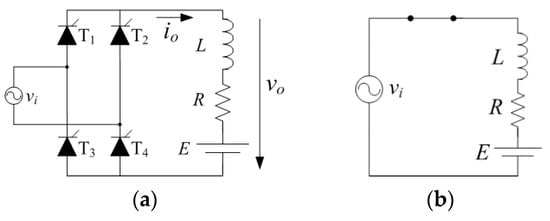
Figure 1.
One-phase full-wave rectifier: (a) electrical circuit; (b) equivalent circuit during conduction.
At start-up or in DCM the initial conditions of the differential equation related to the equivalent circuit in Figure 1b is io(α) = 0, and the corresponding solution is given by:
Equation (1) is valid in the range where γ represents the conduction interval. So, the thyristors turn-off at . The parameter γ is determined based on the bisection method considering:
If γ ≤ π DCM is confirmed Equation (1) describes the current variation. If γ > π CCM is confirmed since the phase delay between the firing of T1T4 and T2T3 is π, which means that a firing is carried out before the current reaches zero. For CCM, Equation (1) does not apply because in this case the initial conditions must satisfy:
The corresponding solution is given by:
and it is valid in the range .
Figure 2 illustrates the current variation in the full-wave rectifier of Figure 1 for the DCM and CCM operation modes. For DCM, represented in case Figure 2a, the current is described by Equation (1) and steady state is always verified. For CCM, represented in case Figure 2b, transient state characterizes the initial current behavior. After the steady state is achieved, the current is described by Equation (7).
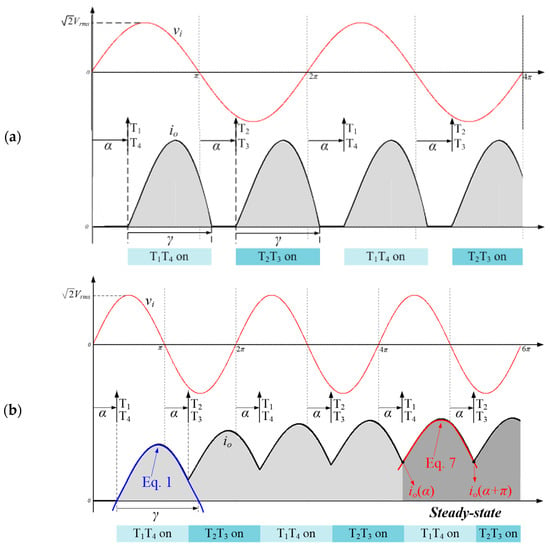
Figure 2.
(a) Discontinuous and (b) continuous modes of operation in the full-wave (bridge) rectifier.
Equations (1) and (7) and their validity ranges enable to plot the voltages of interest, namely vo, vR and vL, using common relationships in electrical circuits:
Figure 3 illustrates the application of the previous relationships considering the CCM scenario. The upper graph shows the variables vo (black) and io (blue), and the lower graph shows the variables vR (blue) and vL (black).
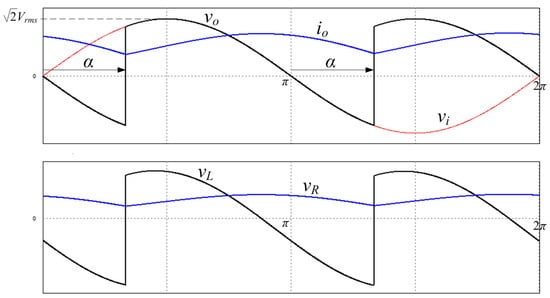
Figure 3.
Example of one-phase full-wave rectifier waveforms (continuous conduction).
It should be pointed out that every time a parameter is changed by the user, Equation (1) changes. Therefore, the first root of Equation (5) must be determined in order to get the value of γ and identify the operating mode (DCM or CCM). This process of root finding is implemented in CORES using the standard bisection method with an adequate tolerance as stopping criteria such that the application preservers its “real time” characteristics.
This approach can be applied to other rectifier topologies (three-phase half-bridge rectifier and three-phase full-bridge rectifier) with the necessary adaptations.
2.2. Application Features
The developed application is based on JavaScript and runs in any browser, allowing its execution in any device (PC, tablet, smartphone), thus avoiding the need for software installation. On the other hand, the rectifier circuits are presented to the user in a built form, where the control circuit is transparent to the user, such that the user should only choose one of the available topologies and focus on circuit analysis by varying the thyristors firing angle as the main control parameter. Moreover, the source characteristic (maximum voltage) as well as the load characteristic (defined by the resistive (R), inductive (L) and counter electromotive force (E) components) can be changed. This allows the user to simulate all possible theoretical scenarios and operating modes (DCM or CCM). The load voltage waveform and load current waveform are plotted by default considering the steady-state circuit operation. However other circuit variables can be selected. Based on user selected parameter values, the application identifies the correct operating mode (DCM or CCM) and the corresponding mathematical equations that describe the load current and the several voltages. The application has been carefully coded so that this process is extremely fast and the update of the waveforms is practically instantaneous. This is a significant advantage compared to common electrical circuit simulators where simulation time can vary between some units to tens of seconds. The user interface is organized as follows. At the start the user can choose one converter topology among the implemented topologies by clicking on it as illustrated in Figure 4:
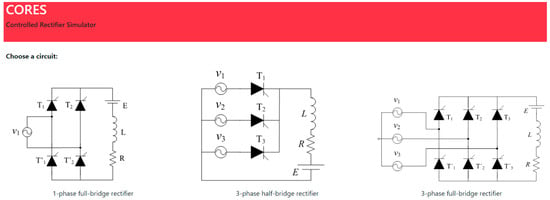
Figure 4.
CORES main interface.
- One-phase full-wave (bridge) rectifier
- Three-phase half-bridge rectifier
- Three-phase full-bridge rectifier
Figure 5 shows a result window with an information set corresponding to several zones labeled A to D, as explained below:
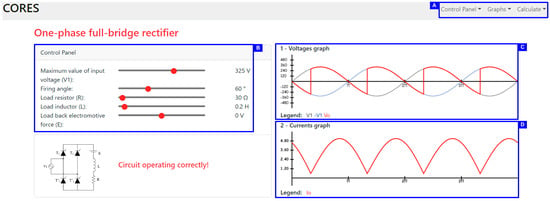
Figure 5.
CORES interface for a selected circuit.
A zone: This is the CORES menu where the user can change some settings. The most relevant are the parameter’s slider range of variation (minimum and maximum) and the waveforms selection as illustrated in Figure 5. Other settings include the scale type (manual or automatic) and the waveform’s color selection. From this menu the user can also inspect the maximum values of load voltage and load current, as well as the average value (DC component) of load voltage and load current. This information is important since in a controlled rectifier (AC/DC) the main feature is the ability to control the output DC component. If the thyristors’ firing angle is varied in its full range (0 to π) the user can observe that the average value of load voltage varies between a maximum (positive) value and a minimum (negative) value, confirming that the converter can operate in rectifier mode (α < π/2) or inverter mode (α > π/2).
B zone: Sliders to set the values of the thyristors firing angle (α), the source characteristic (maximum voltage) and the load characteristics (defined by the resistive (R), inductive (L) and counter electromotive force (E) components). The selected value is indicated by the red dot within the available interval represented by the grey bar.
C zone: The area where the output voltage waveform is plotted (in red). The load voltage is plotted by default. Input voltage (v1) and its symmetrical (−v1) are also represented for a better understanding of the relationship between output and input voltages. The user can select other circuit voltages as illustrated in Figure 6 such as the resistor voltage, inductor voltage or thyristor voltage. This feature is particularly relevant since it enables the user to detail the circuit analysis by relating several variables and confirm several theoretical concepts.
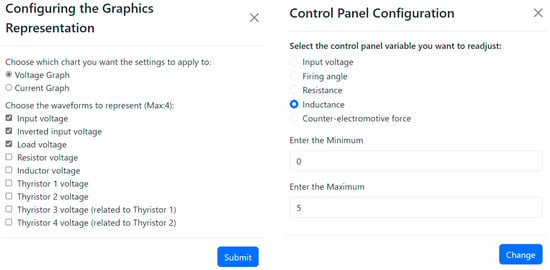
Figure 6.
Example of some configuration options in CORES.
D zone: The area where the load current waveform is plotted.
The software has intentionally a simple graphical user interface with a self-explaining nature. The amount of text was reduced to a minimum since students tend to dislike reading large text blocks.
2.3. Examples of CORES Usage
The next figures illustrate the use of CORES in different operating modes in the one-phase full-wave rectifier. Figure 7 exemplifies DCM and CCM. In this example it was enough to change the inductive parameter from 0.2 H to 0.8 H. By making the RLE load more inductive there are no conditions for the current to decrease to zero, thus assuring CCM. In DCM the effect of the counter electromotive force (E = −30 V) in the load voltage is clear. As expected, the effect is visible when there are no devices conducting. Otherwise, the load voltage is the function of the input voltage.
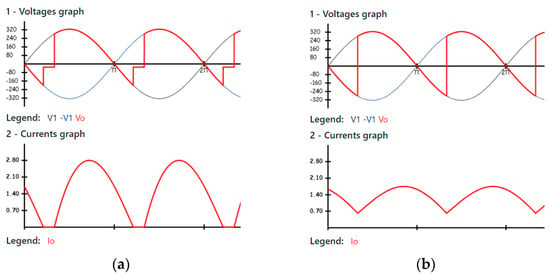
Figure 7.
DCM (a) and CCM (b) in CORES one-phase full-wave (bridge) rectifier.
The following example (Figure 8) illustrates the operation of the one-phase bridge rectifier with a constant output current. The user must understand that a high inductive load must be chosen. The more inductive the load, the lower the current ripple. In this example the load resistive component was set to 25 Ω and the inductive component to 4 H. The simulation of this scenario in CORES is extremely simple and fast. It is a matter of changing the load characteristic until the current waveform presents a constant behavior, since CORES represents all waveforms at steady state based on appropriated current expression as the function of select parameter values set by the user. In a common circuit simulator this is not a simple task since a trial-and-error approach must be used, by managing the load characteristics and the simulation time in order to assure that steady state has been reached with constant output current.
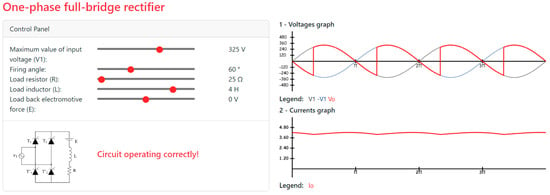
Figure 8.
Constant output current operation in the one-phase bridge rectifier.
The example in Figure 9 illustrates the operation of the three-phase half-bridge rectifier in inverter mode of operation. The output voltage waveform is plotted in red. For a better understanding of the relationship between output and input voltages, the 3-phase system voltages (v1, v2, v3) are also represented with different colors. This mode is characterized by a negative average value of the output voltage which is clear in inspecting the output voltage waveform. The user should realize that a necessary condition is that the thyristor’s firing angle must be greater than 90 degrees (120 degrees in the example). A second necessary condition is the existence of a negative counter electromotive force (E), which must be negative enough to maintain the current flowing on the load. In the example in Figure 9 E = −150 V giving rise to a DCM.
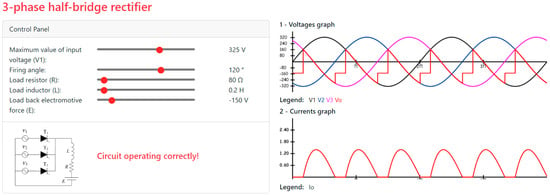
Figure 9.
Inverter operation mode in CORES three-phase half-bridge rectifier.
In the last example (Figure 10) we explore further the previous topic. The thyristor’s firing angle was decreased to 90 degrees such that the average value of the output voltage is zero. Still, there is current at the load and particularly in CCM due to the negative counter electromotive force. From a theoretical perspective, the mathematical expression that justifies the previous analysis is:
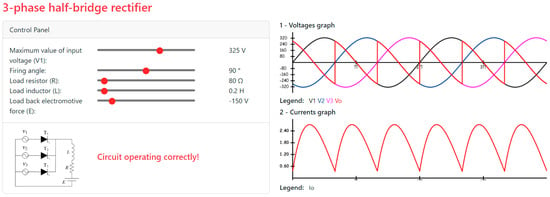
Figure 10.
CCM operation mode in CORES three-phase half-bridge rectifier.
3. Discussion
The validation of the CORES application was conducted with 51 students who attended the Power Electronics discipline of the Electrical and Computer Engineering Bachelor degree of the Engineering School of the Porto Polytechnic. Students used the CORES and PSIM simulators throughout the whole semester and in the end the students’ results and their perception of use were assessed. To better analyze the software’s usability and impact on the students’ assimilation of theoretical concepts, students also evaluated the circuit simulator PSIM used in the course. This way it was possible to compare the perception of the students in relation to both simulators.
The validation was mainly conducted through a quantitative research process using a closed questionnaire. This was later complemented through a qualitative approach based on the collection of students’ open comments. Table 1 lists the questions proposed to students, in the form of a statement. Students classified each statement in a Lickert scale (5 level):

Table 1.
Student assessment of the CORES simulator.
- 5—fully agree
- 4—partially agree
- 3—neutral
- 2—partially disagree
- 1—fully disagree
The overall average score across all survey statements, using the provided average scores, is approximately 4.36. This confirms our earlier findings and suggests a high level of agreement or satisfaction among the respondents. The standard deviations of the survey responses range from 0.60 to 0.97, with an average standard deviation of 0.82. This range indicates varying levels of agreement among respondents across different statements but not overly different. The top statements with the highest average scores are the following:
- “CORES is easy to understand and use”: this statement received the highest average score, indicating that users find CORES very intuitive and user-friendly. Such a high score reflects well on the system’s design and usability, suggesting that it meets the needs of its users effectively in terms of ease of use and understandability.
- “CORES responds to my actions quickly”: the high score for this statement suggests that CORES is perceived as a responsive system. Quick response to user actions is crucial in ensuring a positive user experience, and this score indicates that CORES is performing well in this aspect.
- “CORES helped me understand the relationship between different parameters”: this statement’s high score reveals that CORES is effective in helping users understand complex relationships between different parameters. This is indicative of good educational value and effective information presentation within the system.
On the other hand, the bottom statements with the lowest average scores were the following:
- “In CORES, the thyristor trigger circuit is transparent and understandable”: while still above 4, this statement score indicates that the aspects related to the thyristor trigger circuit in CORES might be somewhat less transparent or understandable compared to other features.
- “CORES helped me understand the process of continuous and discontinuous conduction”: this statement, with a score slightly above 4, suggests that while CORES is helpful in understanding the various conduction regimes, there might be room for improvement in how it conveys this particular aspect.
- “CORES enables the simulation of various circuits effectively”: as the statement with the lowest average score, it indicates that users find the simulation of different circuits in CORES to be less effective compared to other features. This area might benefit from additional attention or enhancement to improve user satisfaction.
The qualitative comments related also to the usability and efficacy of the tool, and the main drawback was related to the limited number of circuits that were then available:
- “CORES has the potential to be better than other simulators in the study for power electronics. However, there has to be a strong investment to contemplate all the circuits studied, under penalty of becoming a tool of limited use. In my case, I used it only for the circuits I had but I quickly turned to the PSIM, since I could perform different tests, in order to understand how the circuits work. However, the time spent was considerably longer. The abstraction and speed of use brought by CORES seems very important to me, so if I had all the circuits I would hardly use other simulators (in a less analytical logic, more focused on the influence of the components on the behavior of the circuit)”.
- “The only weak point, from my point of view, will be the fact that there are only the 3 main circuits, so the existence of others would be something valuable”.
- “It would be fruitful to have more diversity and better ability to adjust circuit specificities”.
- “It could have more circuits, or better yet, allow the construction of circuits. Maybe something to put as a job for a next student who can give continuity. I find it a very useful application for the quick understanding of circuits”.
- “CORES is very easy to use and allows you to clearly understand the behavior of the circuits. I could count on more model circuits and/or allow you to create new ones and save them as models”.
- “An excellent graphical tool to reconcile with the analytical resolution of an exercise”.
- “Some implementations are still missing”.
- “It could be extended to work with more topologies (circuits)”.
- “Weaknesses: does not have waveforms of the voltage drop of semiconductors with discontinuous conduction”.
- “You can’t have more than four waves”.
- “There should be more types of circuits”.
4. Conclusions
Active student participation in the learning process is a relevant factor on the achievement of learning outcomes. Adopting instructional practices that engage students in the learning process is therefore paramount. Digital simulations are interactive tools modelling a physical system that have the potential to motivate and involve students in active experiential learning processes that promote higher-order thinking skills.
This paper presents the development of a JavaScript application that simulates the behavior of thyristor-controlled rectifiers, which is a relevant topic in Power Electronics courses. The user can vary the load characteristics and the thyristors firing angle, and then analyze the corresponding influence on the circuit behavior, by relating the load current waveform to the several circuit voltages available. Since the results are updated in real time, a better understanding of the theoretical foundations is fostered. The application only requires the use of a browser (online or offline) and there is no need for installation or plugins. The application’s characteristics described along this paper are innovative and are not present in any previous published software, to the best of the authors’ knowledge. CORES has proven to be a valuable pedagogical tool.
Author Contributions
Conceptualization, F.C. and R.C.; methodology, R.C.; software, F.C.; validation, R.C. and C.V.d.C.; formal analysis, C.V.d.C.; investigation, F.C.; resources, R.C.; data curation, R.C.; writing—original draft preparation, R.C.; writing—review and editing, C.V.d.C.; visualization, F.C.; supervision, R.C.; project administration, R.C.; funding acquisition, R.C. All authors have read and agreed to the published version of the manuscript.
Funding
This research received no external funding.
Institutional Review Board Statement
Informed consent was obtained from all subjects involved in the study.
Data Availability Statement
Data is publicly available upon request through the contact email.
Conflicts of Interest
Author Filipe Carvalho was employed by the company Decskill—Tecnologias de Informação. The remaining authors declare that the research was conducted in the absence of any commercial or financial relationships that could be construed as a potential conflict of interest.
References
- Bonwell, C.C.; Eison, J.A. Active Learning: Creating Excitement in the Classroom. ASHE-ERIC Higher Education Reports; The George Washington University: Washington, DC, USA, 1991; pp. 1–12. [Google Scholar]
- Prince, M. Does Active Learning Work? A Review of the Research. J. Eng. Educ. 2004, 93, 223–231. [Google Scholar] [CrossRef]
- Freeman, S.; Eddy, S.L.; McDonough, M.; Smith, M.K.; Okoroafor, N.; Jordt, H.; Wenderoth, M.P. Active learning increases student performance in science, engineering, and mathematics. Proc. Natl. Acad. Sci. USA 2014, 111, 8410–8415. [Google Scholar] [CrossRef] [PubMed]
- Barrows, H.S.; Tamblyn, R.M. Problem-Based Learning: An Approach to Medical Education; Springer Publishing Company: Berlin/Heidelberg, Germany, 1980. [Google Scholar]
- Etkina, E.; Karelina, A.; Ruibal-Villasenor, M. Inquiry-based physics tutorials. Am. J. Phys. 2010, 78, 419–425. [Google Scholar]
- Thomas, J.W. A Review of Research on Project-Based Learning; Autodesk Foundation: San Francisco, CA, USA, 2000. [Google Scholar]
- Cohn, D. Active learning. Vet. Rec. 2013, 172, 9–14. [Google Scholar] [CrossRef] [PubMed]
- Vaz de Carvalho, C.; Bauters, M. Technology to Support Active Learning in Higher Education. In Technology Supported Active Learning; Lecture Notes in Information Technology; Springer: Berlin/Heidelberg, Germany, 2021; pp. 1–11. [Google Scholar]
- Tobin, K.; Capie, W.; Bettencourt, A. Active teaching for higher cognitive learning in science. Int. J. Sci. Educ. 1988, 10, 17–27. [Google Scholar] [CrossRef]
- Faria, A.J.; Hutchinson, L.; Power, D.J. A framework for the design of supply chain simulator games. Comput. Ind. 2015, 71, 41–55. [Google Scholar]
- Tsalapatas, H.; Vaz de Carvalho, C.; Heidmann, O.; Houstis, E. Active Problem-Based Learning for Engineering Higher Education. In Proceedings of the 11th International Conference on Computer Supported Education, Heraklion, Greece, 2–4 May 2019; pp. 347–351. [Google Scholar]
- Madhuri, G.; Kantamreddi, V.; Goteti, L. Promoting higher order thinking skills using inquiry-based learning. Eur. J. Eng. Educ. 2012, 37, 117–123. [Google Scholar] [CrossRef]
- Asok, D.; Abirami, A.; Angeline, N.; Lavanya, R. Active Learning Environment for Achieving Higher-Order Thinking Skills in Engineering Education. In Proceedings of the 2016 IEEE 4th International Conference on MOOCs, Innovation and Technology in Education (MITE), Madurai, India, 9–10 December 2016; pp. 47–53. [Google Scholar] [CrossRef]
- Sorby, S.A.; Baartmans, B.J. The development and assessment of a course for enhancing the 3-D spatial visualization skills of first-year engineering students. J. Eng. Educ. 2000, 89, 301–307. [Google Scholar] [CrossRef]
- Lattuca, L.R.; Terenzini, P.T.; Volkwein, J.F. Engineering change: A study of the impact of EC2000. Int. J. Eng. Educ. 2006, 22, 574–584. [Google Scholar]
- Wang, W.; Sharma, A.; Lin, C.H.; Ji, Z. Teaching professional engineering skills with electronic circuit simulators. Int. J. Electr. Eng. Educ. 2013, 50, 117–127. [Google Scholar]
- Umetani, K.; Ishihara, M.; Hiraki, E. Design of Embedded Experiments in Power Electronics Class. In Proceedings of the 2023 IEEE 10th International Conference on E-Learning in Industrial Electronics (ICELIE), Singapore, 16–19 October 2023; pp. 1–6. [Google Scholar]
- Roy, C.; Kim, N.; Cox, R.; Parkhideh, B. Development of a Power Electronics Teaching Lab Incorporating WBG Semiconductors with Plug and Play Modular Hardware and Advanced Curriculum. In Proceedings of the 2019 IEEE Energy Conversion Congress and Exposition (ECCE), Baltimore, MD, USA, 29 September–3 October 2019; pp. 2432–2438. [Google Scholar]
- Flores-Arias, J.M.; Moreno-Munoz, A.; Bellido, J.; Linan, M. Active learning in power electronics: From classroom to laboratory. In Proceedings of the IEEE EDUCON 2010 Conference, Madrid, Spain, 14–16 April 2010; pp. 1451–1454. [Google Scholar]
- Sterman, J.D. Learning in and about complex systems. Syst. Dyn. Rev. 1994, 10, 291–330. [Google Scholar] [CrossRef]
- Adams, R.S.; Turns, J.; Atman, C.J. Educating effective engineering designers: The role of reflective practice. Des. Stud. 2012, 33, 657–682. [Google Scholar] [CrossRef]
- Vaz de Carvalho, C. Virtual Experiential Learning in Engineering Education. In Proceedings of the 2019 IEEE Frontiers in Education Conference (FIE), Covington, KY, USA, 16–19 October 2019; pp. 1–8. [Google Scholar]
- Velaora, C.; Dimos, I.; Tsagiopoulou, S.; Kakarountas, A. A Game-Based Learning Approach in Digital Design Course to Enhance Students’ Competency. Information 2022, 13, 177. [Google Scholar] [CrossRef]
- Deterding, S.; Dixon, D.; Khaled, R.; Nacke, L. From game design elements to gamefulness: Defining “gamification”. In Proceedings of the 15th International Academic MindTrek Conference: Envisioning Future Media Environments, Tampere, Finland, 28–30 September 2011; pp. 9–15. [Google Scholar]
- Maseda, F.; Martija, I.; Martija, I. An active learning methodology in power electronic education. In Proceedings of the 2014 IEEE Frontiers in Education Conference (FIE) Proceedings, Madrid, Spain, 22–25 October 2014; pp. 1–5. [Google Scholar] [CrossRef]
- Goldemberg, C.; Pellini, E.; Kaiser, W.; Komatsu, W. A Python based power electronics E-learning tool. In Proceedings of the 2009 Brazilian Power Electronics Conference, Bonito-Mato Grosso do Sul, Brazil, 27 September–1 October 2009; pp. 1088–1092. [Google Scholar] [CrossRef]
- Khader, S.; Hadad, A.; Abu-aisheh, A. The application of PSIM Matlab/Simulink in power electronics courses. In Proceedings of the 2011 IEEE Global Engineering Education Conference (EDUCON), Amman, Jordan, 4–6 April 2011; pp. 118–121. [Google Scholar] [CrossRef]
- Li, H.; Chen, G. Study in the Application of PSIM Software in the Teaching of Curriculums Related to the New Energy Power Generation. Adv. Mater. Res. 2014, 986–987, 551–555. [Google Scholar] [CrossRef]
- Chibante, R.; Vaz De Carvalho, C.; Ferreira, P. A simulation tool to promote active learning of controlled rectifiers. Comput. Appl. Eng. Educ. 2018, 26, 688–699. [Google Scholar] [CrossRef]
Disclaimer/Publisher’s Note: The statements, opinions and data contained in all publications are solely those of the individual author(s) and contributor(s) and not of MDPI and/or the editor(s). MDPI and/or the editor(s) disclaim responsibility for any injury to people or property resulting from any ideas, methods, instructions or products referred to in the content. |
© 2024 by the authors. Licensee MDPI, Basel, Switzerland. This article is an open access article distributed under the terms and conditions of the Creative Commons Attribution (CC BY) license (https://creativecommons.org/licenses/by/4.0/).